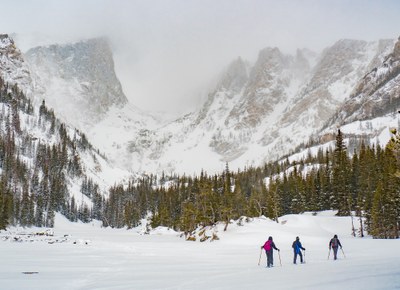
Snowshoeing Course
Beginner Snowshoe Clinic - Northern Colorado
This is a basic class where we teach fundamentals of snowshoeing including various types of snowshoes and fitting them, trail etiquette and techniques including breaking trail, and fall recovery. We will also cover winter safety.
- Sun, Feb 18, 2024
- Committee: Northern Colorado
- FREE
- Availability: FULL, 5 on waitlist (10 capacity)
- Cancellation & Refund Policy
A week before the course I will send out particulars on meeting time/place and our destination.
What we will cover in this workshop:
Equipment
Types of snowshoes/ poles with snow baskets
Poles - A must-have accessory. With baskets. Good for stability and extraction from tree wells, rock wells, and mishaps on thin ice. Good for probing the snow ahead of you, for example, on a snow bridge over a creek. Adjust straps properly especially for gloved hands.
Snowshoes
- Heel Lifts - A useful feature on any snowshoe that they may purchase.
- Binding Snowshoes to Boots -pull the straps tight enough. People walk out of snowshoes or one person keeps losing a shoe due to inadequate binding tightening. MSRs are especially prone to this.
- Some snowshoes flip up in back (Atlas) and some stay flat (MSR)
- Women centric snowshoes
- Snow Shoe Length More length needed for more weight and deeper powder snow.
MicroSpikes - Often used on icy trails in lieu of snowshoes. Spikes also tend to work better on long frozen-lake crossings. One person without spikes can slow the whole group down.
Backpack - Review options for attaching snowshoes to a backpack. Winter packs tend to be larger than standard summer daypack.
Trail Etiquette and Safety
- Trail Tracks Stay in SS tracks or break trail, If possible, stay off XC ski tracks.
- Pace Line/Breaking Trail - First person breaks trail, second person walks where first person didn't thereby creating a trench, third person neatens it all up. Everyone else in the line won't even know they are in fresh snow unless you cycle through giving each person a shot at the lead. Ask for volunteers if the trail-breaking gets tough.
- Hidden Obstacles - Tree wells, rock wells, fallen trees, rocks, etc. that are lurking under the snow and hidden from view. Probe with their poles if unsure.
- Thin Ice - The creeks in RMNP don't freeze solid. Water is always running underneath. It is possible to break through and get wet. Bring spare socks for winter outings that cross a lot of creeks. If you do break through, get your foot out ASAP as the water will instantly freeze to the snowshoe making it that much harder to extract.
- Getting up from a fall – snowshoes on downhill side, weight over feet, put weight on crossed poles if necessary
- Steep ascents – dig toes firmly into the snow
- Don't Walk Backwards - Doesn't works in snowshoes!
Clothing
- Dress in layers – easy to add or subtract layers as you warm up/cool down
- Cotton Kills - No cotton (especially when wet, doesn't insulate)– Wool, polyester, synthetics best
- Warm hiking boots
- Gaiters – especially for deep snow
- Toe and hand warmers
- Sunglasses/sunscreen
Winter safety
- 10 essentials
- Avalanche Awareness
- Nutrition/water
- Lunch/snacks and water ( even in winter!)
Where to snowshoe in Northern Colorado
- Consistent snow in Poudre Canyon above the Big South trail head, Cameron Pass, Moose Center, etc.
- RMNP – Upper Bear Lake Road especially good above Glacier Gorge - Check with park rangers
- Other areas - Wyoming Snowy Range, Indian Peaks
Badges you will earn:
This course has no scheduled activities.
Snowshoes and poles - We will have an opportunity to rent in Estes Park
10 essentials
- Navigation – map, compass
- Headlamp – lighting with batteries
- Sun protection – sunglasses, hat clothing, SPF lotion
- First Aid
- Knife
- Fire – matches, lighter
- Extra Water
- Shelter – like an emergency bivy
- Extra Food -
- Extra Clothing -
You must register for this course to see course materials.

 Basic Snowshoeing Course
Basic Snowshoeing Course